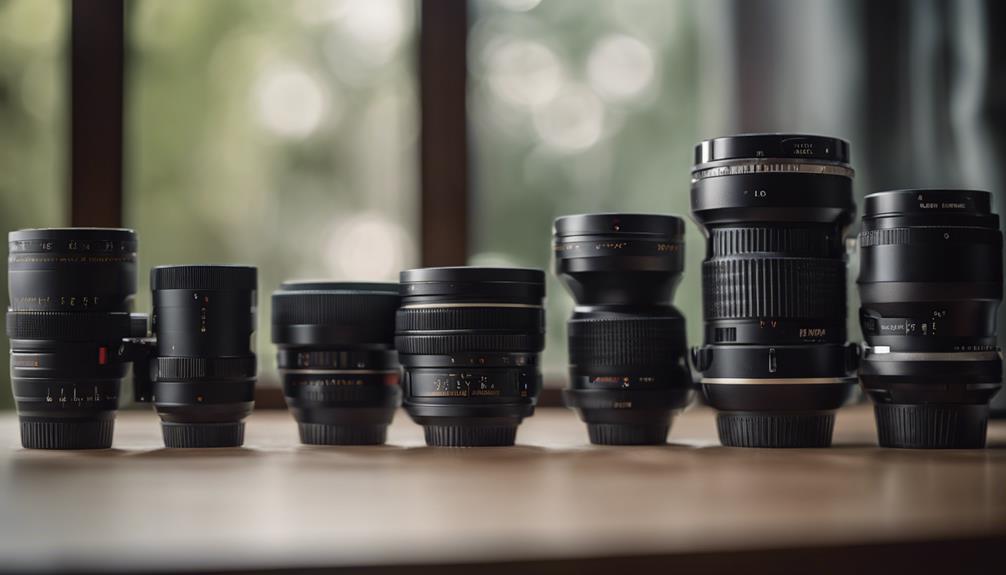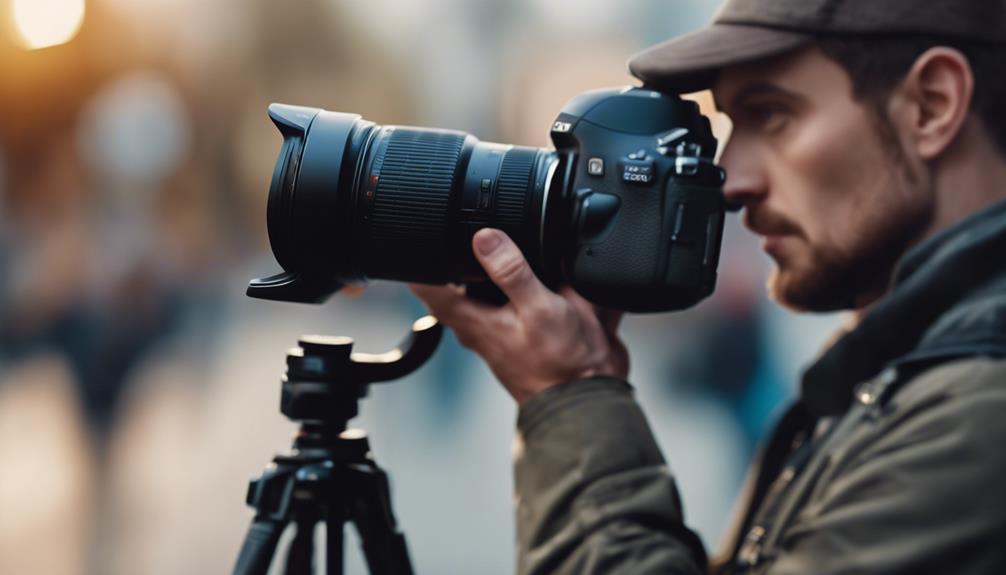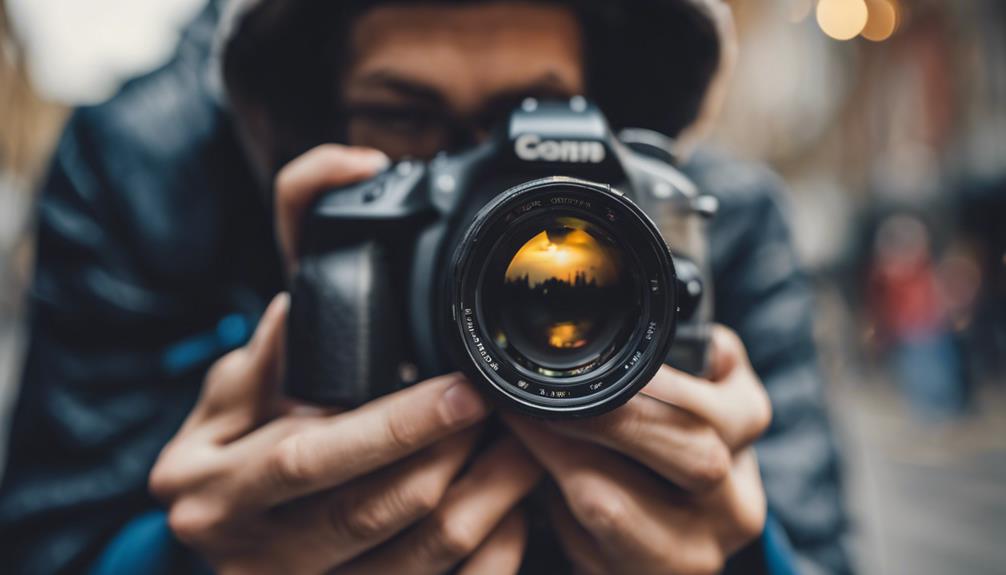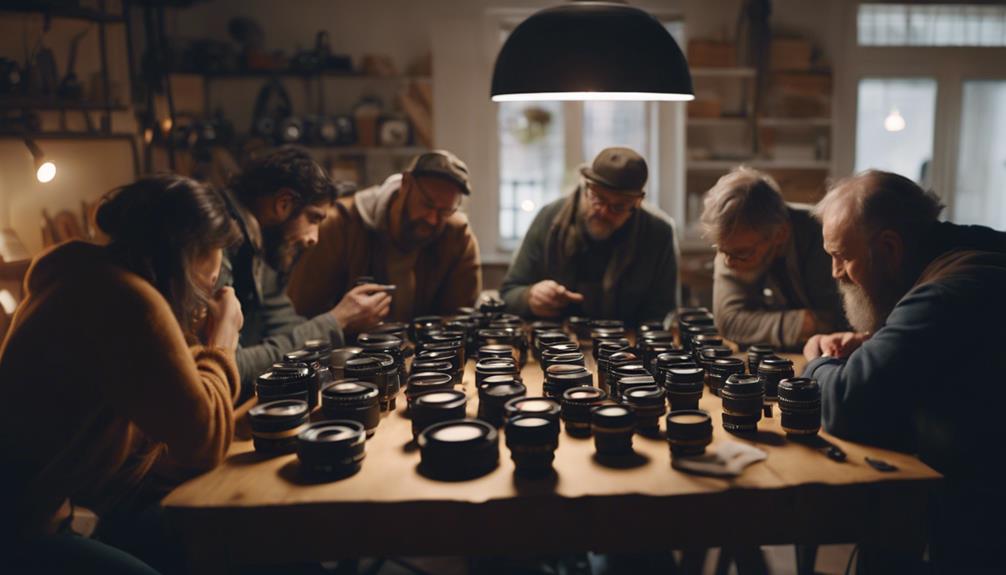To choose the right lens for your photography without breaking the bank, you'll need to examine lens specifications closely. For wider scenes, opt for a lower focal length; for detailed, zoomed-in shots, choose a higher focal length. Consider maximum aperture — a low f-number like f/1.4 excels in low light conditions. If autofocus speed is crucial, particularly for sports or wildlife photography, look for a lens with USM for quick and silent focusing. Analyze your budget and consider either prime lenses for sharper images or zoom lenses for versatility. This approach aligns your gear with specific photographic requirements, efficiently enhancing your photographic output. Remember, further exploration reveals additional insights into optimizing lens selection effectively.
Understanding Lens Specifications

Before delving into lens choices, it's essential you understand key lens specifications—namely focal length, aperture, and image stabilization—which directly impact your photography results. Focal length, measured in millimeters, determines the lens's angle of view and magnification capabilities, affecting how much of the scene fits within your frame. A lower number indicates a wider view, while a higher number offers a tighter focus, ideal for details or distant subjects.
Aperture, expressed as f-numbers, defines the lens's ability to gather light and the depth of field in your images. A lower f-number, like f/1.4, means a wider aperture, allowing more light and facilitating faster shutter speeds. This range is important for working in varied lighting conditions and achieving a blurred background or 'bokeh' effect. It's important to take into account the aperture range when selecting a lens, as it affects both exposure and artistic expression.
Furthermore, lens coatings are engineered to enhance performance by minimizing reflections and flare, thereby improving clarity and color fidelity. These coatings are particularly beneficial in challenging lighting scenarios, ensuring that the light transmission remains at its best. When choosing a lens, pay attention to these coatings, as they can have a significant impact on the image quality.
Evaluating Your Photography Style
Now that you understand key lens specifications, it's important to assess how these align with your unique photography style. Consider the typical lighting conditions you encounter. Are you often working in low light environments or shooting under harsh midday sun? This impacts your choice greatly, as different lenses perform variably across lighting scenarios. For example, lenses with larger apertures, such as f/1.4, allow more light to enter, making them ideal for dim settings.
Next, reflect on the subject movement in your shoots. Are you capturing fast-moving sports or serene landscapes? Fast-moving subjects require lenses with quick autofocus capabilities to guarantee sharp images. The autofocus motor type, such as Ultrasonic Motor (USM) or Stepping Motor (STM), plays a critical role here. USM lenses offer faster and near-silent focusing, ideal for sports or wildlife photography where speed is important, and silence is appreciated to avoid startling the subject.
Understanding these aspects of your photography style helps you make informed decisions about which lens features are essential and which you can compromise on to stay within budget. Aligning lens capabilities with your specific needs ensures that you invest in gear that enhances your photographic outcomes without unnecessary expenditures.
Prime Vs. Zoom Lenses

When choosing between prime and zoom lenses, consider their distinct advantages and limitations in relation to your photographic needs. Prime lenses, known for their fixed focal length, offer superior optical quality. The absence of additional internal elements typical in zoom lenses means they generally produce sharper images with less chromatic aberration. Additionally, they often boast wider maximum apertures, facilitating low-light shooting and enabling a shallower depth of field, which is ideal for portraits with that dreamy, blurred background effect.
Conversely, zoom lenses stand out due to their lens versatility. These lenses allow you to cover a range of focal lengths without swapping out gear, making them particularly valuable for dynamic shooting environments like wildlife or sports photography. However, aperture differences between prime and zoom lenses can be significant. Zoom lenses typically have smaller maximum apertures, which can limit their effectiveness in low light conditions and reduce the bokeh effect compared to their prime counterparts.
Budgeting for Photography Equipment
After choosing the perfect lens type, you'll need to take into account your budget for purchasing photography equipment. Cost management is pivotal in ensuring that your investment into photography gear doesn't overrun your financial boundaries. Begin by setting a clear budget. Determine how much you can realistically allocate towards equipment without compromising other financial obligations.
Once your budget is established, explore equipment financing options. Many retailers offer financing plans that allow you to pay over time rather than upfront. This can include low-interest rates or even zero interest for a set period, making high-quality lenses more accessible without an immediate hefty outlay. Be sure to read the terms carefully to avoid hidden fees or high post-promotional interest rates.
Additionally, consider the longevity and potential resale value of the equipment. Investing in high-quality lenses can offer better performance and durability, which translates into cost savings over time due to fewer replacements. Furthermore, well-maintained, high-quality lenses tend to hold their value better, offering the option to recoup some of your investment should you choose to sell later.
Best Lenses for Beginners

For beginner photographers, selecting a lens that offers versatility and ease of use is essential to mastering the basics of photography. When you're starting out, you'll need a lens that can handle a range of situations without overwhelming you with complex features. Here, lens adaptability and focal flexibility are key terms to understand and prioritize.
To help you make an informed choice, consider the following lenses that are renowned for their versatility and ease of use:
- Standard Zoom Lens (24-70mm f/2.8): This lens is a workhorse for beginners, offering a useful range from wide-angle to short telephoto. Its constant aperture of f/2.8 guarantees good performance in low light conditions and provides a shallow depth of field, which is great for portraits and blurring backgrounds.
- 50mm Prime Lens (f/1.8): Known as the 'nifty fifty,' this lens is affordable and exceptionally sharp with a wide aperture. It's excellent for achieving professional-looking results with minimal investment. Its prime focal length encourages you to move around and explore composition, enhancing your photographic eye.
- Telephoto Zoom Lens (70-300mm): This lens extends your reach and is ideal for capturing distant subjects like wildlife or sports. It offers significant focal flexibility, allowing you to experiment with various perspectives and framing from a fixed position.
Where to Find Affordable Lenses
You'll find that online marketplaces, local camera stores, and refurbished equipment dealers are prime sources for affordable lenses suited to your photographic needs. Exploring these avenues, you can unearth deals that balance cost and quality, essential for enhancing your photographic arsenal without straining your budget.
Online marketplaces offer a broad spectrum of lenses, from the latest models to vintage finds. Here, you can compare prices and specifications across multiple sellers, ensuring you secure the best deal. Pay attention to seller ratings and reviews to gauge the reliability of the lens you're considering.
Local camera stores not only provide the opportunity to physically inspect lenses but also often have knowledgeable staff on hand. They can offer invaluable advice on lens compatibility and performance, tailored to your camera body and photography style.
Refurbished deals from certified dealers present a cost-effective option to acquire high-quality lenses. These lenses have been inspected, repaired, and certified to meet original manufacturer standards, offering you like-new performance at a fraction of the cost.
Lastly, consider lens rentals to test high-end lenses before committing to a purchase. This can be an economical strategy to access premium optics for specific projects or to evaluate a lens's suitability for your long-term needs.
Tips for Testing Lenses

Before purchasing a lens, it's crucial to thoroughly test its performance to ensure it meets your specific photographic requirements. Testing not only confirms the lens' compatibility with your camera but also its capability in different shooting conditions.
Here are three critical steps to effectively test lenses:
- Utilize Lens Rentals: Before committing to a purchase, consider renting the lens. Lens rentals are a cost-effective way to evaluate different models and brands without the full investment. Check for rental services that offer a range of lenses you're interested in and use the rental period to perform extensive tests.
- Check Focus Accuracy: Focus accuracy is pivotal for sharp images. Test the autofocus speed and precision in various lighting conditions. Use both manual and autofocus settings to see how well the lens can maintain focus on moving subjects or in low light environments.
- Analyze Image Quality: Examine the images taken with the lens for sharpness, chromatic aberrations, and distortion. Shoot at different apertures and focal lengths to assess the lens' resolution and optical quality across its range. Pay special attention to edge sharpness and how the lens handles highlights and shadows.
Maintaining Your Lenses
Proper maintenance of your lenses is essential to guarantee their best performance and longevity. Developing consistent cleaning routines and employing effective storage solutions will protect your investment and secure sharp, clear images. Here's a detailed guide to maintaining your lenses.
| Maintenance Task | Description |
|---|---|
| Daily Cleaning | Use a blower to remove dust particles before gently wiping the lens with a microfiber cloth. |
| Weekly Inspection | Check for any scratches or molds. Use a magnifying glass to inspect the lens elements. |
| Monthly Deep Clean | Disassemble (if applicable) and use a lens cleaning solution on the glass elements. |
| Storage Handling | Always store lenses in a dry, temperature-controlled environment. Silica gel packets can prevent moisture buildup. |
| Long-term Care | Schedule professional servicing every 1-2 years to recalibrate and clean the internal mechanisms. |
Frequently Asked Questions
Can Different Weather Conditions Affect Lens Performance?
Yes, various weather conditions can greatly impact lens performance.
For example, lens fogging occurs when transitioning from a cold to a warm environment, leading to condensation on the lens elements. To prevent this, you can use anti-fogging sprays or allow your lens to acclimate slowly to temperature changes.
Additionally, high humidity can increase the risk of fungal growth inside the lens, which can deteriorate image quality and harm the lens components.
How Does Lens Weight Impact Shooting Comfort?
Heavier lenses can markedly affect your shooting comfort by increasing lens fatigue. When you're handling a weighty lens for long periods, it can strain your wrists and arms, impacting your stability and endurance.
Opting for lenses with an ergonomic design can mitigate some of these issues. Lighter lenses or those with better weight distribution promote prolonged use without discomfort, enabling you to shoot longer while maintaining technical precision and image quality.
Are Vintage Lenses Compatible With Modern Cameras?
Exploring the compatibility of vintage lenses with modern cameras is like bridging two different eras of technology. Fortunately, lens adapters are your key to accessing this potential.
These adapters vary in quality and functionality, impacting image quality and focusing capabilities. It's crucial to research specific adapter models that match your camera's mount and desired lens.
Opt for reputable brands to guarantee the adapter maintains the lens's peak performance and image sharpness.
Do Lenses Come With Any Warranties or Guarantees?
Yes, lenses typically come with warranties, but the terms vary by manufacturer. You'll find that most new lenses include a limited warranty covering defects in materials and workmanship for a specified period, usually one to two years.
Check the warranty card or manufacturer's website for details on coverage and claim procedures. It's important to grasp these terms to guarantee you're protected against potential issues affecting lens durability.
How Often Should Lenses Be Professionally Cleaned?
Just as you'd schedule regular check-ups for a prized vehicle, your camera lenses also need professional cleaning to maintain peak performance.
The cleaning frequency largely depends on your usage and the environments you shoot in. Generally, it's recommended to have lenses cleaned professionally at least once a year.
Professional services utilize specialized tools and techniques that guarantee thorough cleaning without risking damage, preserving the sharpness and clarity of your photographs.
Conclusion
Congratulations on successfully maneuvering through the intricate world of photography lenses! Remember, nearly 85% of professional photographers suggest investing in quality glass over camera bodies.
As you refine your style, choose lenses that enhance your vision without straining your budget. Whether opting for a versatile zoom or a sharp prime, prioritize durability and image quality.
Don't forget to test lenses and maintain them well. Start with recommended beginner lenses and explore deals on reputable platforms to build an impressive toolkit.

